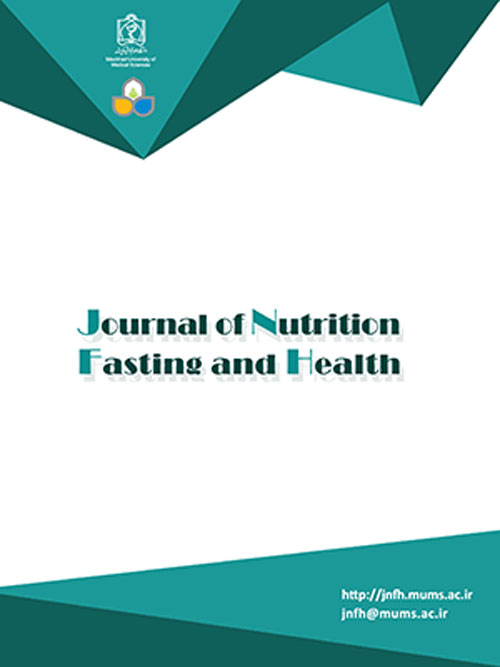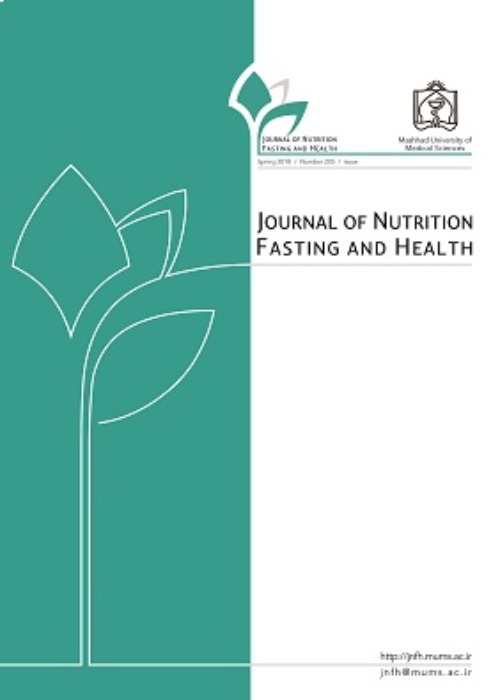فهرست مطالب

Journal of Nutrition, Fasting and Health
Volume:5 Issue: 4, Autumn 2017
- تاریخ انتشار: 1396/10/20
- تعداد عناوین: 7
-
-
Pages 138-143IntroductionIn the holy month of Ramadan, Muslims abstain from eating and drinking during daytime and mostly take two meals per day. One of these major meals is consumed before sunrise (Sahur), and the other is taken after sunset (Iftar). The partial nutritional deprivation in Ramadan may affect the immune system, while the other rituals of this month might render fasting individuals susceptible to various pathological conditions, such as food-borne infections. The present study aimed to evaluate the risk factors of food-borne bacterial diseases in Ramadan.MethodsA comprehensive search was performed via databases such as Google Scholar and PubMed to identify the titles and abstracts of the relevant articles using specific terms regarding food safety issues, Ramadan, and fasting.ResultsThe major risk factors associated with the occurrence of food-borne diseases during Ramadan were inappropriate storage and handling of cooked food products, in-advance preparation of meals, and nutritional deficiency.ConclusionAccording to the results, prevention of food-borne infections during Ramadan requires critical measures, such as the provision of high-quality food ingredients, improving personal hygiene, and cooking and storing of food products at proper temperatures.Keywords: Food safety, Ramadan, foodborne pathogens, Fasting, Bacteria
-
Pages 144-150IntroductionThe present study aimed to assess the effects of Ramadan fasting on micronutrients and their correlations with ocular biometry.MethodsThis prospective study was conducted on 89 healthy volunteers (51 males and 38 females) with the mean of 34.98±9.10 years in Mashhad, Iran. Participants received complete ophthalmic and systemic examinations one week before and one week after the holy month of Ramadan in 2015. Subjects with no history of systemic and ophthalmic diseases were enrolled in the study. Blood samples were obtained from all the participants in the morning in both phases of the study. Levels of micronutrients were measured in the blood samples using the Hitachi 717 analyzer (Hitachi, Japan). In addition, IOLMaster (Carl Zeiss Meditec AG, Germany) was applied to determine the ocular axial length (AL) and anterior chamber depth (ACD).ResultsNo significant differences were observed in the AL and ACD of the subjects before and after Ramadan fasting (P>0.05). Fasting was found to decrease the levels of uric acid, selenium, sodium, and potassium (P0.05). Moreover, no significant association was observed between the AL and ACD with the concentrations of the micronutrients during Ramadan (P>0.05).ConclusionAccording to the results, fasting had no significant effects on the overall health and ocular biometry of the fasting individuals during Ramadan. Therefore, it seems that Ramadan fasting is a safe for healthy adults.Keywords: Anterior chamber depth, Axial length, Micronutrients, Ramadan fasting
-
Pages 151-157IntroductionThirst is one of the main complaints during Islamic fasting. As bread is the staple food among most Muslims, evaluating its impact on thirst is important. In this study, we investigated the effect of licorice-enriched barley bread compared to barley bread and white wheat bread.MethodsThis clinical trial was performed on three consecutive days during Itikaf ceremony. Data were garnered by using a checklist including items on demographic data, weight, height, waist circumference, blood pressure, and pulse rate. Blood pressure and pulse rate measurements were repeated at the end of the study. The participants were divided into three groups receiving functional barley bread enriched with licorice, barley bread, and white wheat bread. The thirst sensation was assessed by Fan visual analogue scale. Also, 24-hour dietary recall was obtained on all the three days.ResultsOverall, 273 people participated in this study. Thirst sensation in the functional barley bread was lower than that in the wheat bread and barley bread groups, but there were no significant differences between wheat and barley bread groups in this regard. During the fasting period, the greatest increase in thirst was observed during the first five hours of fasting in all the three groups, which was significantly lower in the functional barley bread group than the wheat and barley bread groups; however, there was no significant difference between wheat and barley bread groups in this respect. Finally, similar results were attained following fluid intake adjustment.ConclusionThis study showed that licorice enrichment of barley bread might alleviate thirst sensation among fasting individuals.Keywords: Islamic fasting, Bread, Functional food, Licorice, Enrichment
-
Pages 158-161Millions of Muslims fast during the month of Ramadan and avoid eating and drinking during this month (1). Fasting is a healthy and non-pharmacological way to improve your health and weight loss (2, 3). During fasting days, nutritional patterns and the amount of food consumed will change (4). It can be concluded that these changes can lead to changes in the metabolism of the human body. The purpose of this review is to investigate the effect of fasting on the rate of secretion and absorption of heavy metals and minerals. According to the former studies during the fasting period, the amount of heavy metal adsorption and disposal and its toxic effects increase. On the other hand, by addition of calcium and phosphorus supplements, it is possible to reduce heavy metal adsorption. Moreover, due to the increase in the absorption of minerals with the empty stomach, individuals with mineral deficiencies can take more of these minerals and trace elements during fasting. Also, Fasting can reduce body mass and release mercury from tissues.Keywords: Fasting, Heavy metal, minerals, Ramadan
-
Health Benefits of Islamic Intermittent FastingPages 162-171Background and ObjectiveIslamic fasting is observed by millions of Muslims across the world during the holy month of Ramadan and other specific days of the lunar year. Fasting Muslims abstain from eating and drinking from dawn until sunset. Depending on season and geographical location, Muslims maintain fasting for approximately 13-18 hours per day. The present study aimed to review the benefits of Islamic fasting.Materials And MethodsThis literature review was conducted via searching in databases like Medline, PubMed, PMC, Google Scholar, ScienceDirect, and reference lists of relevant articles using keywords like health benefits, Islamic fasting, intermittent fasting, alternate-day fasting, time-restricted feeding, and Ramadan intermittent fasting.ResultsIslamic fasting could be considered as intermittent fasting as it is similar to alternate-day fasting and time-restricted feeding. Intermittent fasting is associated with numerous health benefits.ConclusionAccording to this review, some of the main health benefits of Islamic fasting include weight loss, attenuation of metabolic markers (e.g., insulin resistance, blood glucose, and blood pressure), improved lipid profile, prevention of chronic problems (e.g., obesity, diabetes, cardiovascular diseases, and cancer), protection against neurodegeneration, and diminished inflammation.Keywords: Health benefits, Ramadan fasting, Islamic fasting, Intermittent Fasting, Alternate, day fasting, Time, restricted feeding
-
Pages 172-177Type I diabetes mellitus is a common chronic disease in adolescents. According to statistics, 12,243 diabetic Muslims fast in thirteen Islamic countries, 43% of whom have type I diabetes. This longitudinal study was conducted on volunteer adolescents with type I diabetes aged 13-18 years for 15 days using the census method. Three days before Ramadan and during the last three days of the study period, changes in the insulin dose, HbA1C, lipid profile, and body mass index (BMI) were evaluated. Among 10 volunteer patients, eight individuals could complete Ramadan fasting. Blood glucose analysis indicated a significant difference between the reported blood glucose levels (PKeywords: Fasting, Diabetes Mellitus, Adolescents, Ramadan, Blood Glucose
-
Food waste in Gaem and Imam Reza hospitals of Mashhad, IranPages 181-190ObjectiveFood waste is a progressive concern and is contributed to reduce energy and protein intake. The aim of this study is to investigate the amount of food waste in different wards of Qaem and Imam Reza hospitals of Mashhad.
Design and subjects: This cross-sectional study was performed during one week in the Imam Reza and Qaem hospitals. The study population consisted of 425 patients in some wards of two hospitals. We selected participants non-randomly from patients who are hospitalized in two hospitals. The rate of food waste was measured just in lunch meal by using the food residual observational check list. All statistical analyses were done through SPSS version 16. Descriptive statistic was used to define baseline characteristics. Independent sample T-test was used for comparison of food waste between main course and appetizer, crosstab and chi-square test for comparing the main course and appetizer waste based on sex, hospitals and wards and ANOVA used for comparison of age between different degrees of food waste.ResultsIn this study 13.9% of the patients left their food in plate entirely. Food wastage in appetizer was significantly higher than main course (PConclusionFood waste vary by the different hospitals and wards, so in order to decrease the food waste, serving meals based on the wards and patient requirements is a good solution.Keywords: Food wastage, Main course waste, Appetizer waste, Qaem hospital, Imam Reza hospital


